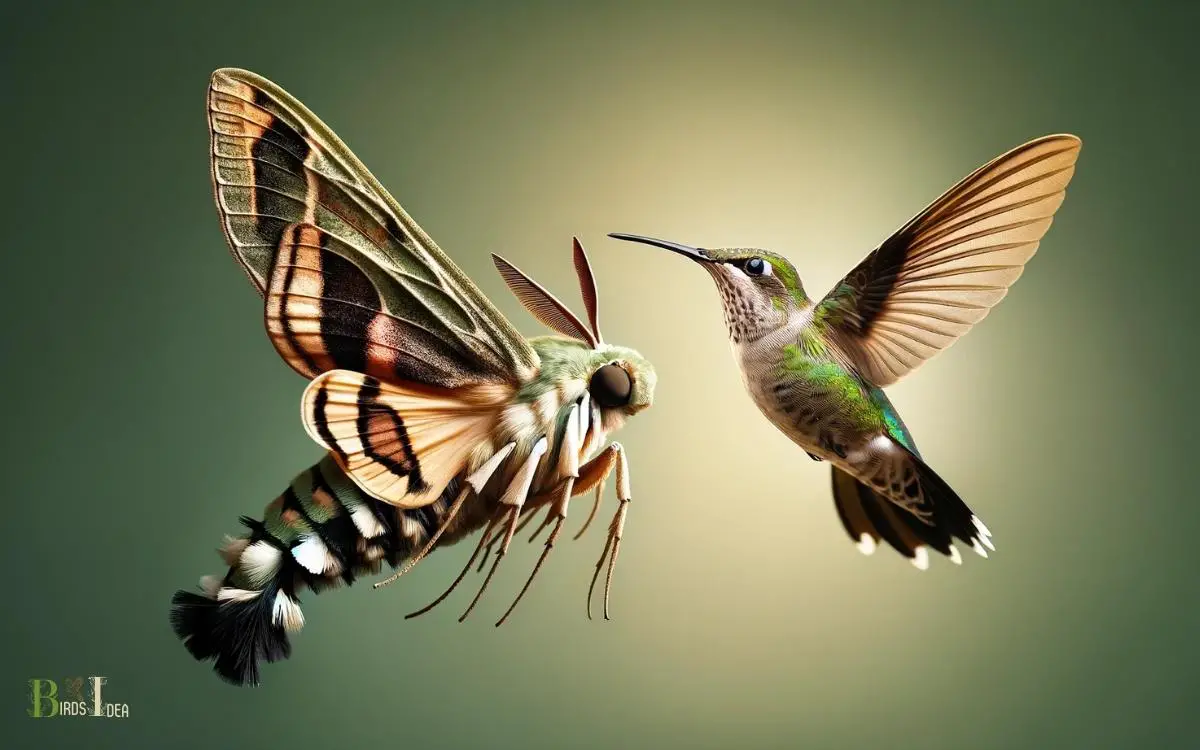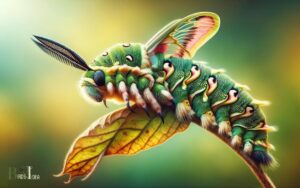Sphinx Moth Looks Like Hummingbird: Discover!
The Sphinx Moth, often confused with hummingbirds due to its appearance and behavior, is a remarkable example of convergent evolution where two unrelated species have developed similar traits.
These moths are known for their ability to hover and fly at high speeds, much like hummingbirds, making them a fascinating subject for both entomologists and birdwatchers.
The Sphinx Moth, also known as the hawk moth or the hummingbird moth, exhibits several characteristics that make it resemble a hummingbird:
These similarities are due to convergent evolution, a process where different species independently evolve similar traits as a result of having to adapt to similar environments or ecological niches.
Discover the Sphinx Moth, a master of mimicry, whose hummingbird-like qualities are a testament to the wonders of natural evolution.

Key Takeaway
Comparison of Sphinx Moth and Hummingbird Traits
| Feature | Sphinx Moth | Hummingbird |
|---|---|---|
| Taxonomy | Insecta (Insects) | Aves (Birds) |
| Family | Sphingidae | Trochilidae |
| Wing Movement | Rapid, up to 85 flaps per second | Rapid, up to 80 flaps per second |
| Hovering Ability | Yes, while feeding on nectar | Yes, while feeding on nectar |
| Feeding Structure | Long proboscis | Long beak and tongue |
| Size | 2.5 to 4 inches in wingspan | 3 to 5 inches in length |
| Nocturnal/Diurnal | Mostly nocturnal, some diurnal | Diurnal |
| Migration | Some species migrate | Many species migrate |
The Resemblance: Sphinx Moth Vs Hummingbird
Resembling a hummingbird in appearance and behavior, the sphinx moth is often mistaken for the avian species due to its rapid wing movement and ability to hover while feeding.
However, despite these similarities, the sphinx moth is a completely different creature, belonging to the order Lepidoptera, which includes moths and butterflies.
While both the sphinx moth and hummingbird are known for their hovering and rapid wingbeats, the moth can be distinguished by its antennae, which aren’t present in birds, and its distinctive proboscis, which it uses to feed on nectar from flowers.
Understanding these differences is crucial to appreciating the unique qualities of the sphinx moth.
Moving on to its physical characteristics, these features further distinguish the sphinx moth from its avian lookalike.
Physical Characteristics of the Sphinx Moth
The Sphinx Moth’s physical characteristics are remarkable, from its hummingbird-like appearance to its unique wing patterns.
These moths are known for their ability to camouflage and mimicry, making them fascinating creatures to study.
Understanding their physical attributes can provide valuable insight into their behavior and survival mechanisms.
Moth’s Hummingbird-Like Appearance
With its streamlined body and rapid wing movements, the sphinx moth closely resembles a hummingbird. Its furry body, tapered wings, and long proboscis contribute to this striking resemblance.
The moth’s ability to hover near flowers while feeding, just like a hummingbird, further adds to the illusion.
The furry body of the sphinx moth also aids in heat retention, allowing it to remain active during cooler evenings, similar to the resilient hummingbird.
This uncanny similarity in appearance and behavior has led to the sphinx moth being frequently mistaken for its avian counterpart.
However, upon closer examination, the distinct physical characteristics of the sphinx moth become apparent, setting it apart as a unique and fascinating creature in its own right.
Transitioning into the subsequent section, the moth’s unique wing patterns also contribute to its mesmerizing appearance.
Unique Wing Patterns
Often mistaken for a hummingbird due to its streamlined body and rapid wing movements, the sphinx moth possesses unique wing patterns that contribute to its mesmerizing appearance.
The intricate wing patterns of the sphinx moth not only aid in its remarkable resemblance to a hummingbird but also serve as a key feature in its camouflage and mimicry tactics.
These patterns, often consisting of bold stripes, intricate lines, or vibrant colors, help the moth blend into its surroundings and confuse predators.
Here’s a breakdown of the sphinx moth’s unique wing patterns:
| Wing Pattern | Description | Function |
|---|---|---|
| Bold Stripes | Disruptive camouflage | Concealment |
| Intricate Lines | Mimicry of other species | Deception |
| Vibrant Colors | Startling predators | Startle response |
Understanding these unique wing patterns provides insight into the sphinx moth’s ability to thrive in diverse environments and evade potential threats. This adaptability is essential for its survival in the wild.
Transitioning to the subsequent section about ‘camouflage and mimicry,’ it becomes evident that the sphinx moth’s wing patterns play a crucial role in its overall defense mechanisms.
Camouflage and Mimicry
A key physical characteristic of the sphinx moth, crucial to its survival, is its remarkable ability to camouflage and mimic other species through its unique wing patterns.
The moth’s wings often bear patterns that resemble eyes or markings found on predators, deterring potential threats.
This mimicry allows the sphinx moth to blend into its surroundings, making it less susceptible to predation.
Additionally, some species of sphinx moths have wings that resemble the shape and movement of hummingbirds, further aiding in their deception.
This adaptation not only helps the sphinx moth evade predators but also allows it to approach flowers for feeding without causing alarm.
Such remarkable mimicry and camouflage contribute significantly to the survival and success of the sphinx moth in its natural habitat.
This ability to blend in seamlessly and mimic other species provides the sphinx moth with a distinct advantage in its environment.
As a result, the moth can navigate its surroundings effectively and capitalize on its unique adaptations, including its feeding and flight behaviors.
Behavioral Adaptations
The sphinx moth exhibits remarkable behavioral adaptations for feeding and flight. It mimics the feeding behavior of hummingbirds, hovering in front of flowers and darting from bloom to bloom.
This moth’s rapid wing movement allows it to remain stationary in the air while feeding, resembling the flight patterns of hummingbirds.
With its long proboscis, the sphinx moth can access nectar from deep within flowers, showcasing its specialized feeding adaptation.
Mimicking Hummingbird Feeding
Moths mimic hummingbird feeding behavior to enhance their survival through effective foraging.
By imitating the hovering and rapid darting movements of hummingbirds, sphinx moths are able to access nectar from deep flowers that other insects can’t reach.
This behavioral adaptation allows them to exploit food sources unavailable to other insects, giving them a competitive advantage in foraging.
By adopting this feeding behavior, moths are able to efficiently gather nectar, thus increasing their chances of survival and reproduction.
This mimicry is a remarkable example of how organisms adapt to their environment to thrive. Understanding these behavioral adaptations sheds light on the intricate strategies employed by different species to secure their place in the ecosystem.
This effective foraging behavior is closely tied to the rapid wing movement that enables these moths to mimic the flight patterns of hummingbirds.
Long Proboscis for Nectar
Equipped with a long proboscis, the sphinx moth efficiently extracts nectar from flowers, showcasing its remarkable feeding and flight adaptations.
This specialized feeding organ allows the moth to reach the nectar deep within the flower, providing it with the sustenance needed for its high-energy lifestyle.
The moth’s ability to hover in front of a flower while extending its long proboscis exemplifies its incredible agility and precision.
This unique adaptation enables the sphinx moth to thrive in environments where nectar isn’t easily accessible to other pollinators, highlighting its crucial role in maintaining floral biodiversity.
- Astonishing precision: The moth delicately maneuvers its long proboscis to reach the nectar, demonstrating remarkable control and accuracy.
- Efficient energy extraction: The specialized proboscis allows the moth to swiftly extract nectar, showcasing its exceptional feeding efficiency.
- Vital ecological contribution: The sphinx moth’s ability to access hard-to-reach nectar sources is essential for pollination and ecosystem health.
Role in Pollination and Ecosystem
With its long proboscis, the sphinx moth plays a crucial role in pollination and ecosystem maintenance.
As the moth hovers over flowers to feed on nectar, its body inadvertently collects and transfers pollen from one flower to another, aiding in the fertilization of plants.
This process is essential for the reproduction of various plant species, contributing to the overall biodiversity and stability of the ecosystem.
By facilitating pollination, sphinx moths indirectly support the production of fruits, seeds, and nuts that serve as food sources for numerous other organisms.
Additionally, their interactions with plants can influence the genetic diversity and adaptation of flora.
The symbiotic relationship between sphinx moths and plants underscores their significance in maintaining healthy ecosystems.
Understanding the sphinx moth’s pivotal role in pollination sheds light on its broader ecological impact.
This leads us to the subsequent section about the sphinx moth’s geographic distribution and habitat.
Geographic Distribution and Habitat
The sphinx moth ranges across various habitats in North and South America, favoring regions with abundant nectar-producing flowers for sustenance.
These adaptable creatures can be found in diverse environments, including:
- Lush tropical rainforests
- Arid deserts
- Temperate woodlands
Their ability to thrive in such different habitats showcases the remarkable resilience and flexibility of these fascinating insects.
Are Sphinx Moths and Hummingbird Moths the Same Thing?
The white lined sphinx moth and hummingbird moth are actually the same species. These fascinating creatures go by different names based on their geographic location, but they both possess long proboscises enabling them to feed on nectar similar to hummingbirds. Their rapid wingbeats and agile movements also mimic those of hummingbirds.
Conservation and Threats to the Sphinx Moth
This remarkable insect faces various conservation challenges across its wide geographic range, including habitat loss, pesticide use, and climate change.
In order to ensure the continued survival of the sphinx moth, it’s important to address these threats and implement effective conservation measures.
Habitat loss due to urbanization and agricultural expansion is a significant threat to the sphinx moth, as it restricts the availability of suitable plant species for their larvae and nectar sources for adults.
Pesticide use also poses a risk, as these chemicals can directly harm the moth or deplete their food sources.
Additionally, climate change may disrupt the synchronization between the moth’s life cycle and the availability of food, leading to population declines.
Conservation efforts should focus on preserving and restoring suitable habitats, reducing pesticide usage, and addressing the impacts of climate change to safeguard the future of the sphinx moth.
Conclusion
In the tapestry of nature, the sphinx moth is a masterful mimic, resembling the elegant hummingbird in both appearance and behavior.
Its ability to adapt and thrive in various habitats, while playing a vital role in pollination, highlights its importance in the delicate balance of the ecosystem.
However, the looming threats of habitat loss and climate change cast a shadow over the future of this remarkable creature, urging us to take action to ensure its preservation.






